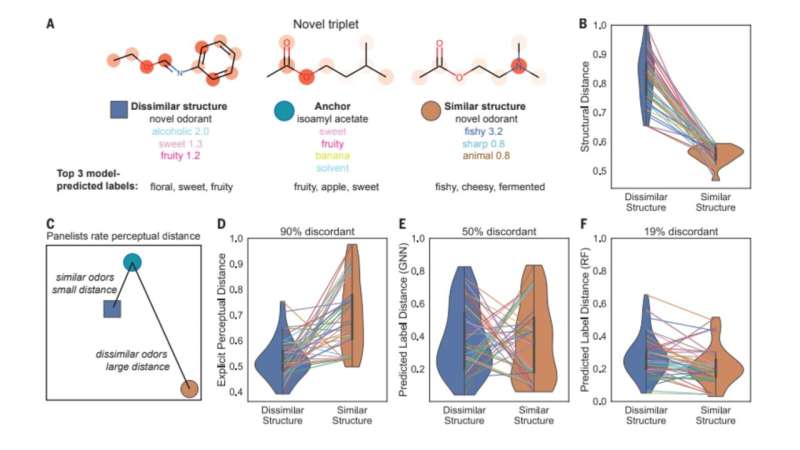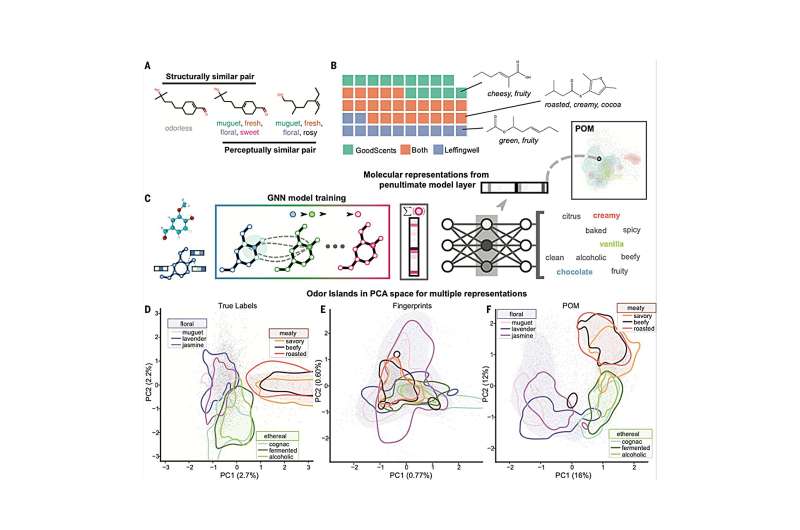A main crux of neuroscience is learning how our senses translate light into sight, sound into hearing, food into taste, and texture into touch. Smell is where these sensory relationships get more complex and perplexing.
To address this question, a research team co-led by the Monell Chemical Senses Center and start-up Osmo, a Cambridge, Mass.-based company spun out of machine learning research done at Google Research, Google DeepMind (formerly known as Google Brain), are investigating how airborne chemicals connect to odor perception in the brain.
To this end they discovered that a machine-learning model has achieved human-level proficiency at describing, in words, how chemicals might smell. Their research appears in the September 1 issue of Science.
“The model addresses age-old gaps in the scientific understanding of the sense of smell,” said senior co-author Joel Mainland, Ph.D., Monell Center Member.
This collaboration moves the world closer to digitizing odors to be recorded and reproduced. It also may identify new odors for the fragrance and flavor industry that could not only decrease dependence on naturally sourced endangered plants, but also identify new functional scents for such uses as mosquito repellent or malodor masking.
How our brains and noses work together
Humans have about 400 functional olfactory receptors. These are proteins at the end of olfactory nerves that connect with airborne molecules to transmit an electrical signal to the olfactory bulb. The number of olfactory receptors is much more than we use for color vision—four—or even taste—about 40.
“In olfaction research, however, the question of what physical properties make an airborne molecule smell the way it does to the brain has remained an enigma,” said Mainland. “But if a computer can discern the relationship between how molecules are shaped and how we ultimately perceive their odors, scientists could use that knowledge to advance the understanding of how our brains and noses work together.”
To address this, Osmo CEO Alex Wiltschko, Ph.D. and his team created a model that learned how to match the prose descriptions of a molecule’s odor with the odor’s molecular structure. The resulting map of these interactions is essentially groupings of similarly smelling odors, like floral sweet and candy sweet.
“Computers have been able to digitize vision and hearing, but not smell—our deepest and oldest sense,” said Wiltschko. “This study proposes and validates a novel data-driven map of human olfaction, matching chemical structure to odor perception.”

POM solves a fundamental set of olfactory prediction tasks. © Osmo AI
What is the smell of garlic or of ozone?
The model was trained using an industry dataset that included the molecular structures and odor qualities of 5,000 known odorants. Data input is the shape of a molecule, and the output is a prediction of which odor words best describe its smell.
To ascertain the efficacy of the model, researchers at Monell conducted a blind validation procedure in which a panel of trained research participants described new molecules, and then compared their answers with the model’s description. The 15 panelists were each given 400 odorants as well as trained to use a set of 55 words—from mint to musty—to describe each molecule.
“Our confidence in this model can only be as good as our confidence in the data we used to test it,” said co-first author Emily Mayhew, Ph.D., who conducted this research while a Monell postdoctoral fellow. She is now an assistant professor at Michigan State University. Brian K. Lee, Ph.D., Google Research, Brain Team, Cambridge, Mass., is also a co-first author.
The Monell team supplied panelists with lab-designed odor reference kits to teach them how to recognize the smells and select the most appropriate words to describe their perception. To avoid pitfalls from past studies like panelist conflation of “musty,” like a wet basement, and “musky,” like a perfume, training sessions and lab-designed odor reference kits taught each panelist the odor quality associated with each descriptive term.
The panelists were asked to select which of the 55 descriptors applied and to rate the extent to which the term best applied to the odor on a 1-to-5 scale for each of the 400 odors. For example, one panelist rated the smell of the previously uncharacterized odorant 2,3-dihydrobenzofuran-5-carboxaldehyde as very powdery (5) and somewhat sweet (3).
Quality control is also important in the final comparison of the human sniffers to the computer model. That’s where co-author Jane Parker, Ph.D., Professor of Flavor Chemistry, University of Reading, UK comes in.
Her team verified the purity of samples used to test the model’s prediction. First, gas chromatography enabled them to separate out each compound in a sample, including any impurities. Next, Parker and her team smelled each separated compound to determine whether any impurity is overwhelming the target molecule’s known odor.
“We did find a few samples with significant impurities, among the 50 tested,” Parker said. In one case, the impurity was from traces of a reagent used in the synthesis of the target molecule and gave the sample a distinctive buttery smell that overpowered the odorant of interest. “In this case we were able to explain why the panel had described the smell differently to the AI prediction.”

The Principal Odor Map (POM) preserves the structure of odor perceptual space. © Osmo AI
Better than a human?
In comparing the model’s performance to that of individual panelists, the model achieved better predictions of the average of the group’s odor ratings than any single panelist in the study, impurities aside. Specifically, the model performed better than the average panelist for 53% of the molecules tested.
“The most surprising result, however, is that the model succeeded at olfactory tasks it was not trained to do,” said Mainland. “The eye-opener was that we never trained it to learn odor strength, but it could nonetheless make accurate predictions.”
The model was able to identify dozens of pairs of structurally dissimilar molecules that had counter-intuitively similar smells, and characterize a wide variety of odor properties, such as odor strength, for 500,000 potential scent molecules. “We hope this map will be useful to researchers in chemistry, olfactory neuroscience, and psychophysics as a new tool for investigating the nature of olfactory sensation,” said Mainland.
What’s next? The team surmises that the model map may be organized based on metabolism, which would be a fundamental shift in how scientists think about odors. In other words, odors that are close to each other on the map, or perceptually similar, are also more likely to be metabolically related. Sensory scientists currently organize molecules the way a chemist would, for example, asking does it have an ester or an aromatic ring?
“Our brains don’t organize odors in this way,” said Mainland. “Instead, this map suggests that our brains may organize odors according to the nutrients from which they derive.”
More information:
Brian K. Lee et al, A principal odor map unifies diverse tasks in olfactory perception, Science (2023). DOI: 10.1126/science.ade4401. www.science.org/doi/10.1126/science.ade4401
Provided by
Monell Chemical Senses Center
Citation:
A step closer to digitizing the sense of smell: Model describes odors better than human panelists (2023, August 31)



